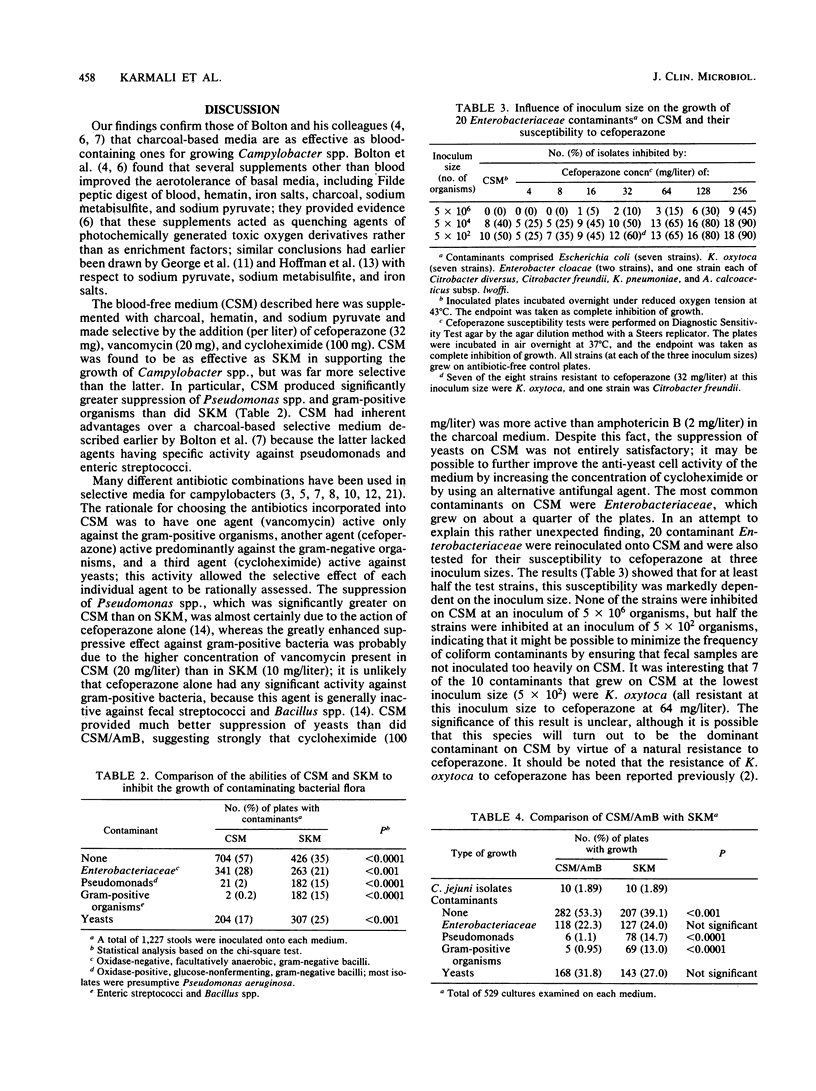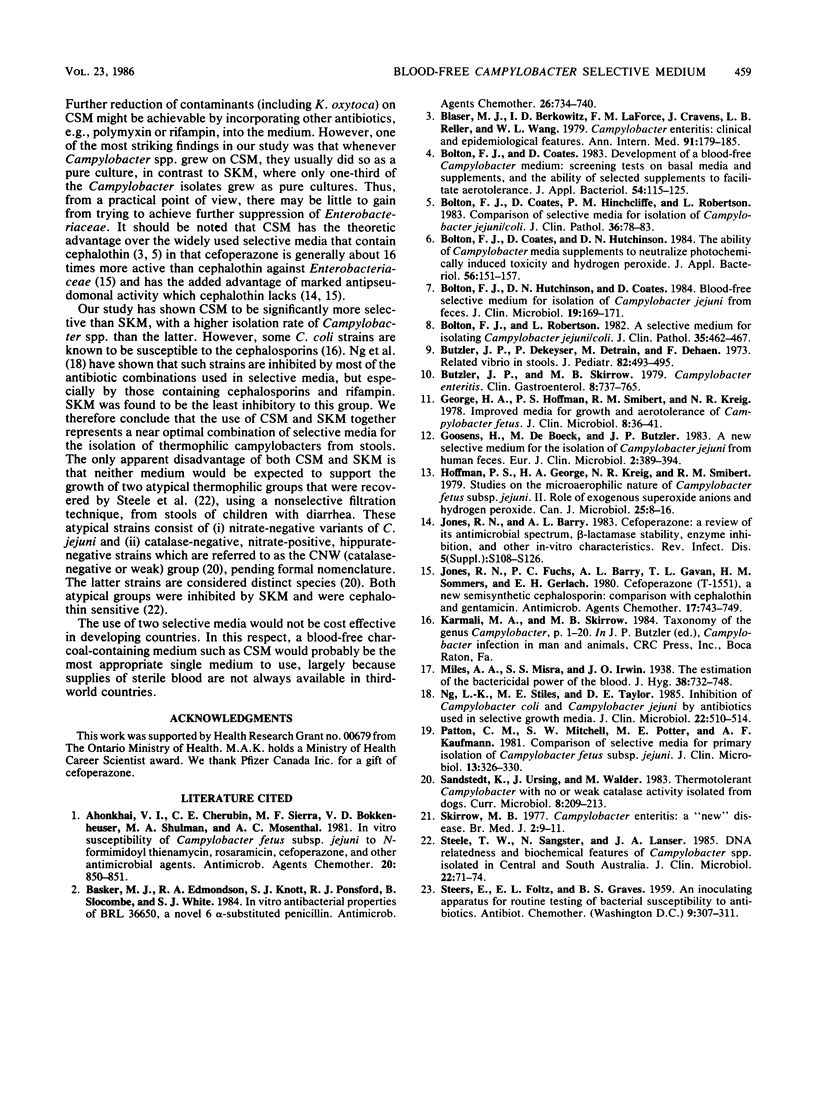Abstract
A blood-free, charcoal-based selective medium (CSM) consisting of a Columbia agar base, activated charcoal (4 g/liter), hematin (0.032 g/liter), sodium pyruvate (0.1 g/liter), cefoperazone (32 mg/liter), vancomycin (20 mg/liter), and cycloheximide (100 mg/liter) supported the growth of Campylobacter jejuni and C. coli with colony counts equivalent to those obtained on antibiotic-free horse blood agar. CSM was compared to Skirrow medium (SKM) for the recovery of C. jejuni and C. coli from stools of patients with diarrhea, the media being incubated for 2 days under reduced oxygen tension at 43 degrees C. These campylobacters were isolated from 35 (2.9%) of 1,227 stools tested (29 on both media, 5 on CSM alone, and one on SKM alone). Whenever C. jejuni and C. coli were recovered, growth was pure on 29 CSM cultures (85%), but on only 11 SKM cultures (37%). Complete suppression of "contaminating" flora occurred in 704 CSM cultures (57%) compared with 426 SKM cultures (35%). CSM more effectively suppressed contaminating pseudomonads, gram-positive organisms, and yeasts than did SKM; both media failed to suppress members of the family Enterobacteriaceae in about a quarter of the samples. Studies on 20 representative Enterobacteriaceae contaminants showed that susceptibility to cefoperazone and growth on CSM were markedly dependent on inoculum size; 12 strains were inhibited by cefoperazone (32 mg/liter) at inoculum sizes of 5 X 10(2) and 5 X 10(4) but not 5 X 10(6) organisms, indicating that the frequency of contaminants on CSM could probably be reduced further by ensuring that stools were not inoculated too heavily on CSM. Our findings confirm that charcoal is an effective substitute for blood in media for growing campylobacters, and that CSM is a highly effective blood-free selective medium for isolating C. jejuni and C. coli from stools.
Full text
PDF



Images in this article
Selected References
These references are in PubMed. This may not be the complete list of references from this article.
- Ahonkhai V. I., Cherubin C. E., Sierra M. F., Bokkenheuser V. D., Shulman M. A., Mosenthal A. C. In vitro susceptibility of Campylobacter fetus subsp. jejuni to N-formimidoyl thienamycin, rosaramicin, cefoperazone, and other antimicrobial agents. Antimicrob Agents Chemother. 1981 Dec;20(6):850–851. doi: 10.1128/aac.20.6.850. [DOI] [PMC free article] [PubMed] [Google Scholar]
- Basker M. J., Edmondson R. A., Knott S. J., Ponsford R. J., Slocombe B., White S. J. In vitro antibacterial properties of BRL 36650, a novel 6 alpha-substituted penicillin. Antimicrob Agents Chemother. 1984 Nov;26(5):734–740. doi: 10.1128/aac.26.5.734. [DOI] [PMC free article] [PubMed] [Google Scholar]
- Blaser M. J., Berkowitz I. D., LaForce F. M., Cravens J., Reller L. B., Wang W. L. Campylobacter enteritis: clinical and epidemiologic features. Ann Intern Med. 1979 Aug;91(2):179–185. doi: 10.7326/0003-4819-91-2-179. [DOI] [PubMed] [Google Scholar]
- Bolton F. J., Coates D. Development of a blood-free Campylobacter medium: screening tests on basal media and supplements, and the ability of selected supplements to facilitate aerotolerance. J Appl Bacteriol. 1983 Feb;54(1):115–125. doi: 10.1111/j.1365-2672.1983.tb01308.x. [DOI] [PubMed] [Google Scholar]
- Bolton F. J., Coates D., Hinchliffe P. M., Robertson L. Comparison of selective media for isolation of Campylobacter jejuni/coli. J Clin Pathol. 1983 Jan;36(1):78–83. doi: 10.1136/jcp.36.1.78. [DOI] [PMC free article] [PubMed] [Google Scholar]
- Bolton F. J., Coates D., Hutchinson D. N. The ability of campylobacter media supplements to neutralize photochemically induced toxicity and hydrogen peroxide. J Appl Bacteriol. 1984 Feb;56(1):151–157. doi: 10.1111/j.1365-2672.1984.tb04707.x. [DOI] [PubMed] [Google Scholar]
- Bolton F. J., Hutchinson D. N., Coates D. Blood-free selective medium for isolation of Campylobacter jejuni from feces. J Clin Microbiol. 1984 Feb;19(2):169–171. doi: 10.1128/jcm.19.2.169-171.1984. [DOI] [PMC free article] [PubMed] [Google Scholar]
- Bolton F. J., Robertson L. A selective medium for isolating Campylobacter jejuni/coli. J Clin Pathol. 1982 Apr;35(4):462–467. doi: 10.1136/jcp.35.4.462. [DOI] [PMC free article] [PubMed] [Google Scholar]
- Butzler J. P., Dekeyser P., Detrain M., Dehaen F. Related vibrio in stools. J Pediatr. 1973 Mar;82(3):493–495. doi: 10.1016/s0022-3476(73)80131-3. [DOI] [PubMed] [Google Scholar]
- Butzler J. P., Skirrow M. B. Campylobacter enteritis. Clin Gastroenterol. 1979 Sep;8(3):737–765. [PubMed] [Google Scholar]
- George H. A., Hoffman P. S., Smibert R. M., Krieg N. R. Improved media for growth and aerotolerance of Campylobacter fetus. J Clin Microbiol. 1978 Jul;8(1):36–41. doi: 10.1128/jcm.8.1.36-41.1978. [DOI] [PMC free article] [PubMed] [Google Scholar]
- Goossens H., De Boeck M., Butzler J. P. A new selective medium for the isolation of Campylobacter jejuni from human faeces. Eur J Clin Microbiol. 1983 Aug;2(4):389–393. doi: 10.1007/BF02019476. [DOI] [PubMed] [Google Scholar]
- Hoffman P. S., George H. A., Krieg N. R., Smibert R. M. Studies of the microaerophilic nature of Campylobacter fetus subsp. jejuni. II. Role of exogenous superoxide anions and hydrogen peroxide. Can J Microbiol. 1979 Jan;25(1):8–16. doi: 10.1139/m79-002. [DOI] [PubMed] [Google Scholar]
- Jones R. N., Barry A. L. Cefoperazone: a review of its antimicrobial spectrum, beta-lactamase stability, enzyme inhibition, and other in vitro characteristics. Rev Infect Dis. 1983 Mar-Apr;5 (Suppl 1):S108–S126. doi: 10.1093/clinids/5.supplement_1.s108. [DOI] [PubMed] [Google Scholar]
- Jones R. N., Fuchs P. C., Barry A. L., Gavan T. L., Sommers H. M., Gerlach E. H. Cefoperazone (T-1551), a new semisynthetic cephalosporin: comparison with cephalothin and gentamicin. Antimicrob Agents Chemother. 1980 Apr;17(4):743–749. doi: 10.1128/aac.17.4.743. [DOI] [PMC free article] [PubMed] [Google Scholar]
- Ng L. K., Stiles M. E., Taylor D. E. Inhibition of Campylobacter coli and Campylobacter jejuni by antibiotics used in selective growth media. J Clin Microbiol. 1985 Oct;22(4):510–514. doi: 10.1128/jcm.22.4.510-514.1985. [DOI] [PMC free article] [PubMed] [Google Scholar]
- Patton C. M., Mitchell S. W., Potter M. E., Kaufmann A. F. Comparison of selective media for primary isolation of Campylobacter fetus subsp. jejuni. J Clin Microbiol. 1981 Feb;13(2):326–330. doi: 10.1128/jcm.13.2.326-330.1981. [DOI] [PMC free article] [PubMed] [Google Scholar]
- Skirrow M. B. Campylobacter enteritis: a "new" disease. Br Med J. 1977 Jul 2;2(6078):9–11. doi: 10.1136/bmj.2.6078.9. [DOI] [PMC free article] [PubMed] [Google Scholar]
- Steele T. W., Sangster N., Lanser J. A. DNA relatedness and biochemical features of Campylobacter spp. isolated in central and South Australia. J Clin Microbiol. 1985 Jul;22(1):71–74. doi: 10.1128/jcm.22.1.71-74.1985. [DOI] [PMC free article] [PubMed] [Google Scholar]



